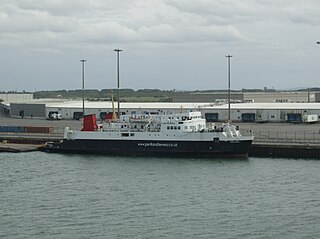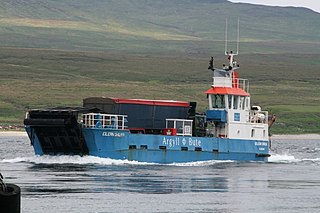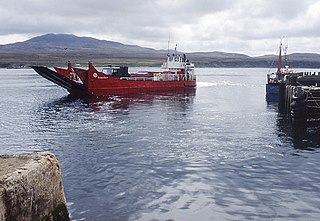
West Loch Tarbert, Argyll is a long and narrow sea loch on the western side of the Kintyre peninsula in Scotland.

West Loch Tarbert, Argyll is a long and narrow sea loch on the western side of the Kintyre peninsula in Scotland.
The head of the loch lies near the village of Tarbert and it reaches the open sea at Ardpatrick Point some 15 kilometres (9.3 mi) distant. [1]
The island of Eilean Ceann na Creige, off the south shore, is connected to the mainland by a causeway. It is the ferry terminal for Islay. [2]
Around the year 1093, Magnus Barefoot, King of Norway had his longship dragged across the isthmus at Tarbert between West Loch Tarbert and East Loch Tarbert as part of a campaign to increase his possessions in the Hebrides. He made an arrangement with King Malcolm III of Scotland that he could take possession of land on the west coast around which a ship could sail. Magnus declared that Kintyre had "better land than the best of the Hebrides", and by taking command of his ship's tiller and "sailing" across the isthmus he was able to claim the entire peninsula, which remained under Norse rule for more than a dozen years as a result. [3]
In the 1960s, Western Ferries began operating a car ferry, with a simple stern-loading ramp, from Kennacraig on the south shore. This served Port Askaig on Islay, in competition with the mail steamer, operated by MacBraynes from West Tarbert near the head of the loch. The new service soon won a significant share of the traffic and stimulated MacBraynes to modernise the Islay route. [4] In January 1970, hoist-loading MV Arran was transferred from the Clyde. She gave two daily return sailings, one each to Port Ellen and Port Askaig, as well as sailings to Craighouse on Jura, Gigha and Colonsay. Over the winter 1972/73, Arran's hoist and side-ramps were removed, along with the superstructure aft of them. She was converted to a stern-loading vessel, with a stern ramp and an open car deck. In this guise, she took on a new timetable – three double crossings a day between modified terminals at Port Ellen and West Loch Tarbert. Port Askaig was left to Western Ferries. [5]
With the introduced of MV Pioneer in August 1974, CalMac started to win back Islay traffic. [4] Over the next five years Pioneer became well established, running to Port Ellen and Gigha. In 1978, Caledonian MacBrayne took over the Western Ferries terminal at Kennacraig, with the deeper-draught MV Iona, again providing a service to both Port Ellen and Port Askaig, as well as calling at Gigha. In 1989, the more spacious, MV Claymore became the Islay ship, with the drive-through MV Isle of Arran taking over in 1993. MV Hebridean Isles became the main Islay vessel in 2001, with MV Finlaggan replacing Isle of Arran in 2011 and relegating Hebridean Isles to the second Islay vessel. [4]

Argyll and Bute is one of 32 unitary authority council areas in Scotland and a lieutenancy area. The current Lord-Lieutenant for Argyll and Bute is Jane Margaret MacLeod. The administrative centre for the council area is in Lochgilphead at Kilmory Castle, a 19th-century Gothic Revival building and estate. The current Council leader is Councillor Robin Currie, a councillor for Kintyre and the Islands.

Caledonian MacBrayne, usually shortened to CalMac, is the major operator of passenger and vehicle ferries, and ferry services, between the mainland of Scotland and 22 of the major islands on Scotland's west coast. Since 2006 the company's official name has been CalMac Ferries Ltd although it still operates as Caledonian MacBrayne. In 2006 it also became a subsidiary of holding company David MacBrayne, which is owned by the Scottish Government.

Kennacraig is a hamlet situated on West Loch Tarbert, a 5 miles (8.0 km) south west of Tarbert on the Kintyre peninsula, Argyll and Bute, in the west of Scotland.

Western Ferries (Clyde) Ltd is a private ferry company with its headquarters in Hunters Quay, Scotland. It currently operates on the Firth of Clyde running a year-round, high-frequency vehicle carrying service between Hunters Quay, near Dunoon, and McInroy's Point, on the outskirts of Gourock in Inverclyde.

The Caledonian MacBrayne fleet is the largest fleet of car and passenger ferries in the United Kingdom, with 34 units in operation and another 2 under construction. The company provides lifeline services to 23 islands off the west coast of Scotland, as well as operating routes in the Firth of Clyde.

MV Hebrides is a ferry owned by Caledonian Maritime Assets Limited and operated by Caledonian MacBrayne from Uig to Lochmaddy and Tarbert, the main settlements of North Uist and Harris respectively.

MV Hebridean Isles is a ro-ro vehicle ferry owned by Caledonian Maritime Assets and operated by Caledonian MacBrayne on the west coast of Scotland. She was the first MacBrayne vessel to be built outside Scotland and the first to be launched sideways. With bow, stern and side ramps, Hebridean Isles is suitable for all the routes served by the large fleet units. After 15 years crossing the Little Minch on the Uig triangle, she now serves Islay.

MV Isle of Arran is a drive-through ferry owned by Caledonian Maritime Assets Limited and operated on the west coast of Scotland by Caledonian MacBrayne. Entering service in 1984, she served on the Arran service for nine years before being moved to Kennacraig. She returned to her original route in 2012, supplementing MV Caledonian Isles in summer and becoming a relief vessel in winter. In 2013, she started a new pilot route from Ardrossan to Campbeltown, which became a permanent fixture in 2015. As of 2022, she is one of the oldest vessels in the fleet, having been in service for 38 years.

MV Pioneer is a stern / side loading ferry built in 1974, in service for 29 years covering nearly all of Caledonian MacBrayne's routes. She now serves the islands of São Tomé and Príncipe in the Gulf of Guinea and was chartered to rescue Liberian refugees.

MV Orcadia is a ro-ro passenger and vehicle ferry. She was operated by Caledonian MacBrayne in the Firth of Clyde in Scotland between 1978 and 2011, for the first decade of her career on the Rothesay crossing. Later, she also saw service on the Dunoon and Brodick crossings, as well as on short cruises around the Clyde. After a lengthy lay-up, she was sold in 2015 to Pentland Ferries to be converted for ferry services and work with the renewable energy sector around Orkney and the Pentland Firth.

MV Pentalina-B was a fast and extremely versatile ferry which operated on a variety of Scottish routes. Launched in 1970 as MV Iona, she was the first drive-through roll-on/roll-off ferry built for the David MacBrayne fleet. She was the first ship in the company's history to have bridge-controlled engines and geared transmission, rather than direct drive. She enjoyed a far-flung career and inaugurated more endloading linkspans than the rest of the fleet put together. Purchased by Pentland Ferries in 1997, she was renamed MV Pentalina-B and operated across the Pentland Firth until the arrival of their new vessel. In 2009, she was sold to a Cape Verde owner.

MV Loch Tarbert is a Caledonian Maritime Assets Limited ro-ro car ferry, built in 1992 and currently operated by Caledonian MacBrayne. She has spent most of her career on the seasonal Claonaig – Lochranza crossing.

MV Finlaggan is a drive-through vehicle and passenger ferry built in Poland for Caledonian Maritime Assets Limited. From 2011, she has been operated by Caledonian MacBrayne on the Islay service from Kennacraig.
MV Lochiel was the Islay mailboat operated by David MacBrayne Ltd from 1939 until 1970. Sinking in West Loch Tarbert in 1960, she was refloated and repaired. She became MacBrayne's last surviving mailboat, seeing out her life as a floating bar in Bristol.

MV Arran was a pioneering Firth of Clyde vehicle ferry introduced by Caledonian Steam Packet Company in 1953. She spent fifteen years on the Upper Clyde crossings, followed by five years at Islay. Initially hoist-loading, via side ramps, these were replaced by a stern ramp in 1973. During her final years with CalMac, she relieved across the network. Several unsuccessful attempts were made to turn her into a floating restaurant, before she was scrapped in 1993.
Caledonian Maritime Assets Limited owns the ferries, ports, harbours and infrastructure for the ferry services serving the west coast of Scotland, the Firth of Clyde and the Northern Isles.

MV Eilean Dhiura is a vehicle ferry operating across the Sound of Islay.

MV Sound of Gigha was a pioneering roll-on/roll-off (ro-ro) ferry operating on the west coast of Scotland. She was launched as Isle of Gigha in May 1966. On 11 November 1966, she capsized off Islay. Salvaged, overhauled, and renamed, she provided thirty years of service between Islay and Jura.
MV Sound of Islay was the first ro-ro ferry on the west coast of Scotland. Built for Western Ferries in 1968, she served Islay and later Campbeltown – Red Bay. In 1981, she was sold to the Government of Newfoundland and Labrador and still operates in eastern Canada.

MV Sound of Jura was the first drive-through car ferry on the west coast of Scotland. She was operated by Western Ferries on the Islay service from Kennacraig between 1969 and 1976. The Mexican Government operated her to Cozumel as Quintana Roo until 2005, when she was wrecked by Hurricane Wilma.